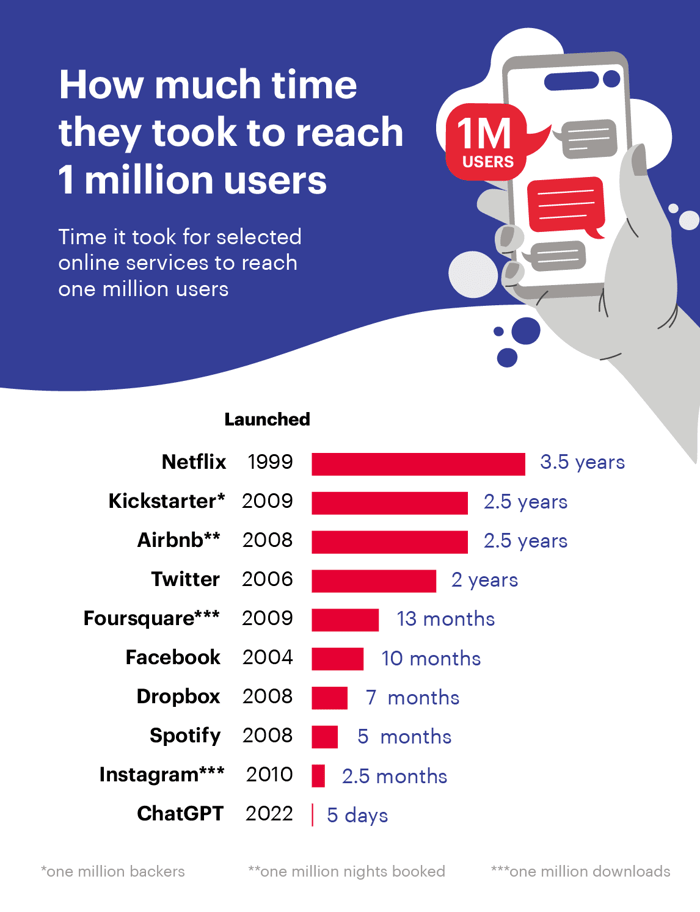In the final months of 2022, generative AI took the giant leap from niche tech subject to mainstream phenomenon and it all came on the back of ChatGPT. While many companies had their own artificial intelligence chatbots in development or even on the market, OpenAI’s all-new version captured the imagination of the world and inspired countless headlines.
Within two months of its November launch, ChatGPT was estimated to have reached 100 million monthly active users1. To put that in perspective, data from Sensor Tower revealed it took TikTok about nine months to reach a similar number and Instagram a comparatively dawdling two and a half years2.
The ChatGPT boom also shone a spotlight on the technology powering it. Its ability to write poems, tell jokes and craft essays that look like they were created by a human left many lay people not only awestruck but wondering how it was possible. The answer partly lies in two areas – generative AI and large language models.
What is generative AI?
Generative AI is a set of algorithms capable of generating seemingly new, realistic content from training data. The term can be broadly used for any AI system whose primary function is to generate content, as opposed to those that perform functions such as classifying data (eg: assigning labels to images) or choosing actions (eg: steering an autonomous vehicle).
 Source: ChatGPT Gets 1 Million Users in Just Five Days - RankingRoyals
Source: ChatGPT Gets 1 Million Users in Just Five Days - RankingRoyals
What is a Large Language Model?
A Large Language Model (LLM) is a particular type of generative AI that uses machine learning to perform a variety of natural language processing (NLP) tasks. In essence, an LLM such as ChatGPT is fed significant amounts of textual data from the internet, samples the dataset and learns to predict what words are needed in a certain situation. Its initial efforts may be inadequate but once a model has been trained long enough on a large enough dataset, it can perform as remarkably as ChatGPT.
Concerns with large language models in customer service
It is little wonder many businesses are keen to leverage ChatGPT and other large language model technologies to perform customer-facing tasks. Increased automation has been proven to reduce costs but many adoptees are realising generative AI faces significant hurdles in the customer service environment.
Hallucinations
Generative AI tools have earned a reputation for generating outputs that sound plausible but are factually incorrect or unrelated to the given context, so much so the habit has earned a moniker of its own – hallucinations. The errors often emerge due to the technology’s inherent biases, lack of real-world understanding or training data limitations. The AI system effectively hallucinates information and while this is never ideal, it is a really serious concern in customer service where accuracy is non-negotiable.
Lack of personalisation
Studies have shown that 80% of consumers are more likely to buy from a company that provides a tailored experience3. ChatGPT is falling short on this front as it cannot give customer-specific data. By the time a customer engages with a chatbot, they have already likely tried self-service and want a direct and personalised response. Generative AI’s failure to deliver is a genuine concern in an environment where customer experience is everything.
Lack of control
Many businesses are learning the hard way that once a generative AI has been trained, it is difficult to control the content it generates. The very fact they are designed to be autonomous means they operate independently and make independent decisions. This means it can be difficult to control their ability to provide customers with inappropriate or harmful responses that may even go against an organisation’s purpose and values.
%20in%20contact-center%20market%2c%202020-2028%20(USD%20Billion).png?width=700&height=442&name=Global%20artificial%20intelligence%20(AI)%20in%20contact-center%20market%2c%202020-2028%20(USD%20Billion).png)
The supervised learning alternative
Supervised learning is a subcategory of machine learning and artificial intelligence that sees the machine learn under supervision. As opposed to generative AI’s go-it-alone approach, supervised learning has the presence of a supervisor as a teacher that essentially trains the machine using data that is well-labelled or already tagged with the correct answer.
A prime example is Oration by Convai, a cloud-based call routing plug-in that enables business users to build, manage and advance their telephone contact customer experience. The technology’s ongoing supervised learning allows administrators to help the advanced speech recognition (ASR) system best match intents with language used by callers. Spending a few minutes each day mapping language to intents is all it takes to keep Oration’s understanding highly tuned and accurate.
An interesting application aspect of generative AI is that Convai is currently investigating using the power of generative AI to speed up the supervision process and help surface greater options to the administrator. This is an existing area that will develop rapidly over the coming years. The reason this is a great use case is that this harnesses the creativity of generative AI with the safety of a human supervisor.
Businesses can deliver rapid business outcomes with supervised learning AI solutions as they provide control and deliver consistent and repeatable customer experiences. Other proven benefits include:
Summary
The AI age has well and truly arrived, with technologies such as ChatGPT set to revolutionise sectors as diverse as healthcare, education and entertainment. In the rush to embrace such opportunities though, businesses need to do their research to ensure they adopt the best solutions to meet their specific needs. Generative AI certainly has benefits but when it comes to customer service, supervised learning is continuing to prove more reliable, allow greater personalisation and ultimately deliver better results.
A growing number of contact centres are investing in technologies that allow customers to verify their identity without needing to interact with human agents. Learn how caller authentication and identification are saving businesses time and money, increasing customer satisfaction and reducing the risk of fraud.





